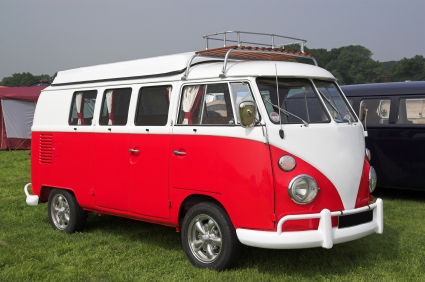article I found and enjoyed.
By: Rachel Mork
Volkswagen bus history dates back to 1949 and was inspired by the VW Beetle and the motorized trolleys common at the time. At a Volkswagen factory in Wolfsburg, Germany, one of the Dutch importers, Ben Pon, sketched a design for a trolley-like bus on a napkin. One year later, Heinz Nordhoff began work on the Volkswagen Bus.
The early Volkswagen buses were called split-window buses, because they had split windscreens, or two front windshields. These buses came in many different models over the years.
- 1949: The very first splitties were called the “workhorses” or the “bulli.” These buses could haul a horse 15 hands high. They were built for hauling cargo instead of for comfort.
- 1950: The Volkswagen Microbus appears on the scene. This VW bus sported two-tone paint and higher-quality upholstery. It was geared more toward transporting passengers than the first model.
- 1951: The Westfalia camper came equipped with furnishings, looking like a house inside a van. The Westfalia was a big hit with young people.
- 1952-1954: Some 30 versions of the Transporter Volkswagen Bus were made during these three years, from delivery vans to ambulance models. The first VW Buses were sold in the United States in 1952.
- 1963: Engines got bigger, a sliding door became a standard feature the VW Bus got a new classification. Germany reclassified all VW Buses as station wagons to avoid paying a new tariff.
- 1967: This was the last year for splitties. Bay-window windscreens replaced the split windscreens. Even bigger engines became available this year, and the electrical systems and general handling of all VW buses improved significantly. Volkswagen buses from this era are considered more reliable than earlier models.
- 1968-1971: The new design of the VW Bus had a different nose that was embraced by many. It used a cheap engine that proved to be inefficient when powering the Westfalia campers, but the interior furnishings of the campers were celebrated. They included a sofa bed, a hand-pump sink, an icebox and rear-facing seats.
- 1972-1975: A new engine, called the Type-4 motor, was introduced in 1972 and honed over the next three years. The interior of the campers was jazzed up with the addition of more sofa beds and brightly colored, plaid upholstery. Gas stoves and refrigerators were available as optional equipment.
1976-1979: These were the last years of the old VW Bus before it was renamed the Vanagon and the VW Camper. The models of these years were roomier; the cabinetry was placed behind the driver’s seat, and the passenger seat was crafted so that it could swivel and face the passengers in the back.
After 1979, the Vanagon and the Eurovan continued the Volkswagen Bus line, but none of these were as funky or eclectic as the early VW buses.

